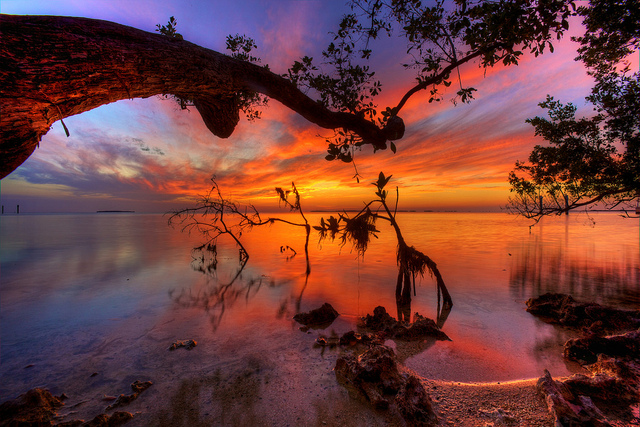
The state with the prettiest name,
the state that floats in brackish water,
held together by mangrave roots
that bear while living oysters in clusters,
and when dead strew white swamps with skeletons,
dotted as if bombarded, with green hummocks
like ancient cannon-balls sprouting grass…
So begins Elizabeth Bishop’s famous ode to the state of Florida. Of course, in a traditional sense, this isn’t an ode, for while it speaks of Florida—almost sings of Florida—it doesn’t call to the region. Like many of Bishop’s poems, which are set apart by their precise descriptions and finely-observed detail, this poem describes Florida to an outsider. It captures a place filled with pelicans and rot and beauty and teenage flesh. Florida feels, to me, like an intimate portrayal drawn from a vast distance.
Yet Bishop didn’t experience Florida from a distance. After moving to Key West in the early 1930’s, Elizabeth decided to stay in the city, moving from apartment to house and enjoying the booming literary scene (as well as the lush surroundings).
Embarrassingly, this is new information for me. I have long admired Elizabeth Bishop’s poetry—I love her confessional style, her raw emotion, and her delicate balance of imagery and abstract—but I insisted on thinking of her as a Massachusetts girl, much like myself. However, the truth is that Bishop didn’t belong to Boston, and even her first book of poems bares testimony to that fact. Titled North and South, the collection jumps back and forth from Key West to Boston, moving from the cold brick and winter twilight of the North to the invading sun and carnival colors of America’s far south. It compares and contrasts the two, never really settling on either, playing to the strengths and terrible weaknesses of both.
But this is, in essence, what I admire so much about Bishop’s poetry. Before I began writing our Key West Friday series, I had never given much though to what I’m going to call her “landscape pieces.” I much preferred her descriptions of love, loss, and anger. But buried within these tantalizing images of a place I have never been (for I haven’t quite made it down to Florida quite yet) is something I can recognize. Reading her poems about Florida is a bit like looking at an old postcard. They provide a fragmented and slightly distorted and appealing picture of America.
Key West is, for Bishop, a place that is filled with growth and overrun with decay. She describes with equal the “enormous turtles, helpless and mild” that are doomed to “die and leave their barnacled shells on the beaches and the fireflies, who come after dark and “map the heavens in the marsh / until the moon rises.” In another poem, titled Florida Deserta, she spends the first stanza discussing summer clouds that “shade the houses / soothe they eyes” and “banish the break-bone fever” before launching into a description of the summer stars. She captures them converging “invisibly on each tin roof,” turning light into color and the shine of hundreds of scales. For Bishop, Florida is alive and pulsing, constantly moving with heat and the glittery refracted light of water and ocean.
After a more thorough exploration, I realize I have to give up Bishop as a fellow Bostonian. She’s much too American to be limited to a single city—even a single state. I think it is her particular skill for imagery, for drawing dreamscapes out of words, but after reading Elizabeth’s lines on Key West, it’s hard not to wonder: what else is out there, waiting with half-closed eyes?
Bishop, in her usual cryptic way, has one answer:
The alligator, who has five distinct calls:
friendliness, love, mating, war, and a warning–
whimpers and speaks in the throat
of the Indian Princess.
